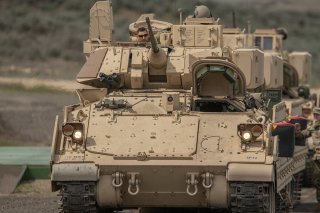Army Scientists Are Building Next-Generation Armor From the Ground Up
As different materials have an array of properties and can be manufactured in different combinations, the Army is able to search for ground-breaking developments.
ABERDEEN PROVING GROUNDS, MD—Closely examining a three-dimensional X-ray of a rotating soldier helmet, Army Research Laboratory (ARL) scientist Dr. Jennifer Sietins looks over a mini-wall of computer screens to analyze the properties and performance specifications of experimental materials being used to develop optimal designs for weapons, vehicles, and other military equipment.
“We are analyzing three-dimensional information. We can evaluate the internal structure of that to ultimately improve performance for the soldier,” Sietins, a materials engineer for U.S. Army Combat Capabilities Development Command, told the National Interest in an interview.
The concept is to innovate with combinations and layers of novel materials, with the ultimate aim of analyzing their properties. Once performance parameters can be identified, scientists are much better positioned to architect the weapons of the future. The process involves analyzing combinations of substances at the microscopic level and creating new, better-performing materials.
“We are using advanced manufacturing techniques to enhance the ballistic forms of armor,” Dr. Nicholas Ku, a materials engineer with the ARL’s ceramic and transparent materials branch, told the National Interest in an interview.
“A lot of academic work has shown [that] if you do control the way these composites are assembled, you can see how cracks initiate. … You can see how layer structure can make a material tougher,” Ku said.
As different materials have an array of properties and can be manufactured in different combinations, the ARL is able to experiment and search for ground-breaking developments in new materials. Perhaps new mixtures of compounds can greatly reduce cracking or penetration in a manner that outperforms traditional armor? That could lead to safer or more lethal armored vehicles, stronger helmets, or paradigm-changing ammunition.
Kris Osborn is the Defense Editor for the National Interest. Osborn previously served at the Pentagon as a Highly Qualified Expert with the Office of the Assistant Secretary of the Army—Acquisition, Logistics & Technology. Osborn has also worked as an anchor and on-air military specialist at national TV networks. He has appeared as a guest military expert on Fox News, MSNBC, The Military Channel, and The History Channel. He also has a Master's Degree in Comparative Literature from Columbia University.
Image: DVIDS.

